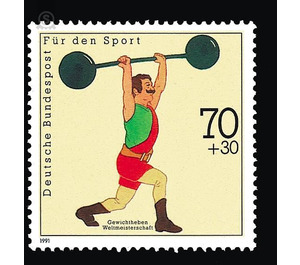sport aid - Germany / Federal Republic of Germany 1991 - 70 Pfennig
| Country | Germany / Federal Republic of Germany |
| Issue Date | 1991 |
| Face Value | 70.00 |
| Color | yellow |
| Perforation | K 13 3/4 |
| Printing Type | Six-color offset printing |
| Stamp Type | Postage stamp |
| Item Type | Stamp |
| Chronological Issue Number | 1372 |
| Chronological Chapter | GER-BRD |
| SID | 849571 |
| In 27 Wishlists | |
"Lifting weights" is as old as humanity and still fulfills a vital function that is important for thousands of years in everyday life. From the "lifting weights" the competitive weightlifting to the determination of the strongest man of the city, the region or the world developed very early. Muscle and strength measuring with weights was, as grave finds in Egypt prove, already 2,000 years BC. Chr. The organized weightlifting, which was and is controlled by various associations, has existed since 1891. At that time, the German Athletics Sports Association (DASV) was founded. In 1896 weightlifting was part of the program of the first Olympic Games in Athens. German weightlifters have played a significant role in international championships at all times. Among the best-known athletes are the Olympic champions Kurt Helbig, Josef Straßberger, Rudolf Ismayr, Josef Manger, Rolf Milser and Joachim Kunz, but the world champions Rudolf Mang, Peter Wenzel, Jürgen Heuser and Manfred Nerlinger also have great respect. Among the 134 national members of the World Organization IWF (International Weightlifting Federation), the Germans have a respected top position thanks to their good performance. One of the special achievements of German weightlifters is the invention of the disc dumbbell with ball bearings shortly before the First World War (1911) by the Frankfurt sports teacher Franz Veltum, who modernized the weightlifting with this dumbbell. Weightlifting until the mid-eighties was a pure men's sport, so now the ladies have gone to the dumbbell and determined their first German champions.


